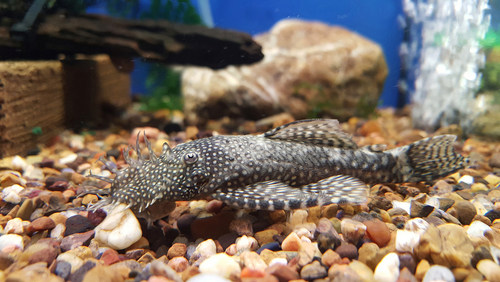You need to be aware of many things if you want to create a successful and thriving aquarium, and who can live alongside whom is key. Plecos have long been one of the most popular bottom dwellers, but which fish can you have swimming above and around them?
Here, we’re going to cover the 13 best Pleco tank mates for building the perfect community.
Contents
What You Should Know – Pleco Tank Mates
Plecos are actually quite a varied family of armored suckermouth catfish, and different types of Plecos can have very different personalities and needs. The Common Pleco (Hypostomus plecostomus), for example, is quite energetic and greedy and will grow to nearly 2 feet in length!
In this article, however, we’re going to talk about the smaller-sized and much gentler species that are most popular for home aquariums – such as the Bristlenose Pleco, Rubber Lip Pleco, and Clown Pleco. They’re relatively similar in terms of their personalities and requirements, and they are much easier to look after.
No matter what species you are caring for, it can be very difficult to find other fish that will be happy in the same space. Every unique species has its own needs, and they can get in each others’ space, take each others’ food, or even harm one another.
Water Parameters ; Tank Conditions
Firstly, any fish living in the same tank have to be comfortable in the same kind of water – and the tank setup will need to support everybody inside. Smaller Plecos have pretty standard water needs for tropical fish, and are happiest with:
- Water Temp: 74 to 80 °F
- pH Level: 6.5 to 7.8
- Nitrate Levels: 40ppm or lower
- Hardness: 8 to 12 KH
In terms of the tank itself, they like to have a good amount of filtration and oxygenation, as they are used to living in fast-flowing rivers where the water is frequently refreshed. They also spend most of the time either relaxing somewhere safe or foraging for food, so they should have rocks or wood to hide around and plants and decorations to explore.
Adult Size
Another really important aspect of putting multiple species in the same place is their comparative size. New hobbyists are often keen to have loads of variety in a community tank, but this can often lead to disasters. Large fish almost always try to eat smaller fish, or at least harass them and cause them stress.
Fortunately, small Plecos are very docile for their size, and spend their time suctioned to the bottom of the tank – so this is one species that can actually live comfortably with much smaller fish without causing any problems.
Bristlenose, Rubber Lip, and Clown Plecos all grow to between 4 and 6 inches as adults, but they are rarely dangerous to even very small tank mates.
Personality ; Temperament
The next pitfall to watch out for is housing aggressive fish in the same space as other species, as they can cause serious harm to one another or make each other very unhappy.
These smaller Plecos are very relaxed and unassuming, and will almost never interact with the other fish in their tank. This makes them perfect additions to most communities, as long as the species they are kept with are likely to leave them alone too.
It’s best to look for other non-aggressive fish, but some more boisterous species can be fine, as long as they do not occupy the same part of the tank.
Resource Competition
The last thing to keep in mind is whether or not all of the fish in your tank will get what they need on a day-to-day basis. Food is obviously a vital resource that all of your fish will need to have access to, but space is critical as well.
4 to 6-inch Plecos need a tank of at least 30 gallons in size, but this may need to be larger if there are other fish occupying the lower portion of the tank with them. Also, while they will scavenge and eat algae and leftovers, they should be getting high-quality fish food every day as well.
Make sure that greedy surface-dwellers are not stealing everything before it gets a chance to reach your Plecos. It’s best to feed them at night, as Plecos are nocturnal feeders and other fish are likely to be less active at this time.
13 Best Pleco Tank Mates
Now that we know what these smaller Plecos need from their space and their new friends, we can find out who those new friends might be! There are a lot of great options out there, but we’re going to start with those that are going to be the happiest, healthiest, and easiest to look after.
Also read:
1. Guppies
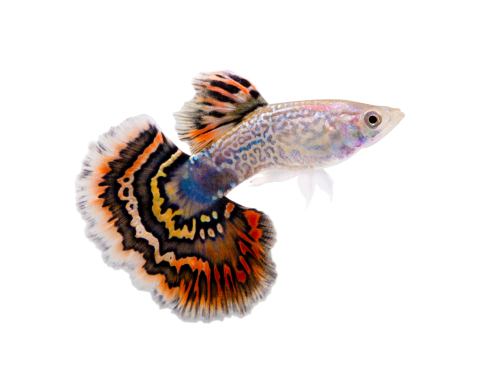
- Scientific Name: Poecilia reticulata
- Other Compatible Species: Cory Catfish, Swordtails, Mollies
- Full Size: 0.5 to 2 inches
- Care Difficulty: Easy
- Origin: South America
Is there a more famous aquarium fish than the sweet and friendly Guppy? These beautiful creatures are easy to keep happy and absolutely stunning to look at, but they are small and have flowing fins so they can be pretty vulnerable to larger or more aggressive species.
Fortunately, small Plecos are perfect tank mates for them, making a varied and interesting community!
Pros:
- Attractive, varied appearance, and easy to care for
Cons:
- Vulnerable to aggressive or larger species and need to live in a group of at least 5
2. Mollies
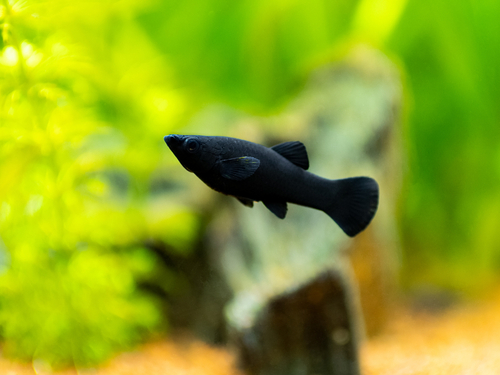
- Scientific Name: Poecilia sphenops
- Other Compatible Species: Danios, Tetras, Loaches
- Full Size: 3 to 5 inches
- Care Difficulty: Easy
- Origin: South US and Central America
Another sweet and calm schooling fish that will get along very well with Plecos is the humble Molly. Those that have been bred in captivity can have very distinctive coloring, and they usually spend their time near the top of the tank – far away from a Pleco – but they also like to relax in hiding places like caves or plants.
Pros:
- Simple needs and active during the day and night
Cons:
- Can be aggressive if their tank is too crowded and need a group of at least 4
3. Platies
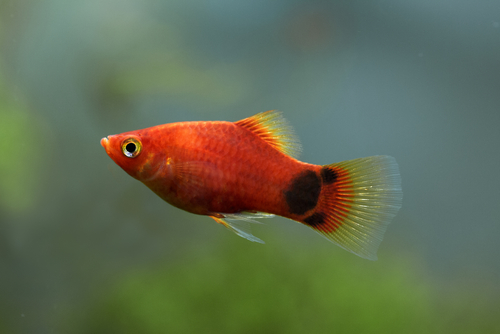
- Scientific Name: Xiphophorus maculatus
- Other Compatible Species: Tetras, Rasboras, Cory Catfish
- Full Size: 2 to 3 inches
- Care Difficulty: Easy
- Origin: Central America and Mexico
Platy fish are another species that are considered very easy to care for and will almost never have a problem with a Pleco at the bottom of their tank. They come in a lot of different colors and with a lot of different variations – often being bred with other similar species as well.
Pros:
- Easy to look after, active swimmers, and come in a lot of varieties
Cons:
- Prefer an elongated tank that they can move around in
4. Swordtails
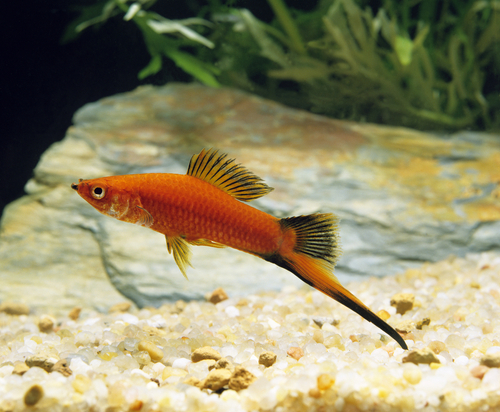
- Scientific Name: Xiphophorus hellerii
- Other Compatible Species: Platies, Mollies, Barbs
- Full Size: 4 to 6 inches
- Care Difficulty: Easy
- Origin: Central America and Mexico
Swordtails are quite similar to Platies, and are in fact often bred together, but they have a very distinctive sharp tail fin that really stands out. They’re also very calm and easygoing, so they are good tank mates for a lot of other species.
Pros:
- Distinctive appearance and peaceful personality
Cons:
- A little larger and like to have additional room to move, as well as some dense vegetation
5. Zebra Danios
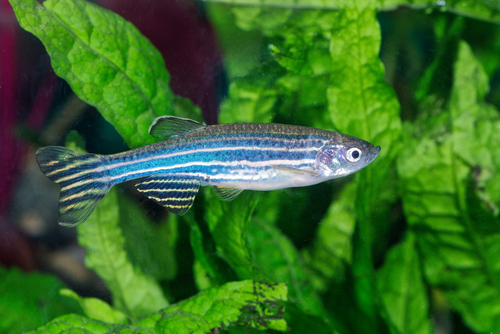
- Scientific Name: Danio rerio
- Other Compatible Species: Small Cichlids, Tetras, Platies
- Full Size: 1.5 to 2.5 inches
- Care Difficulty: Easy
- Origin: India and Bangladesh
Zebra Danios are not the only Danio species that will happily live alongside your Plecos, but they are probably the most popular. They have wonderful dark stripes that give them their name, and they are both active and peaceful – making them the perfect addition for a calm community.
Pros:
- Unique pattern, active, and friendly.
Cons:
- Can be vulnerable to large or aggressive species.
6. Dwarf Gourami

- Scientific Name: Trichogaster lalius
- Other Compatible Species: Mollies, Guppies, Platies
- Full Size: 4 to 4.5 inches
- Care Difficulty: Intermediate
- Origin: India, Bangladesh, and Pakistan
Some Gourami species can grow to a massive 28 inches, but Dwarf Gourami are much more reasonable in size. They can have very mesmerizing patterns on their scales and wonderfully vibrant coloring, and they are generally quite timid and shy, so they are not going to harass your Plecos in any way.
Pros:
- Vibrant color, shy, and spend most of their time at the top of the tank
Cons:
- Like to have lots of places to hide and feel more comfortable in lower light conditions
7. Tiger Barbs
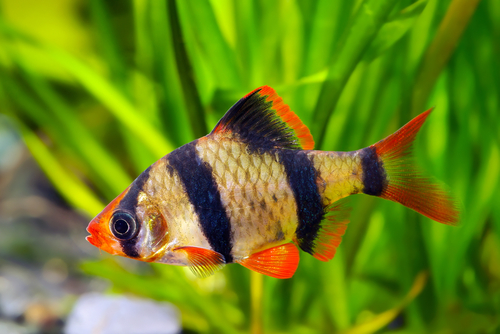
- Scientific Name: Puntius tetrazona
- Other Compatible Species: Mollies, Swordtails, Platies
- Full Size: 2 to 3 inches
- Care Difficulty: Easy
- Origin: Malaysia and Borneo
The strong black bands and golden/silver bodies of Tiger Barbs make them stand out in any tank, and they are really fun to look after as well. They can be a little domineering with their tank mates, which is more annoying than it is harmful, but they usually leave Plecos alone. These fish like to show off and will make a very entertaining addition to your tank.
Pros:
- Strong coloring and patterns, and active personalities.
Cons:
- Can harass their tank mates and will become stressed if they are alone or with only one other individual
8. Neon Tetras

- Scientific Name: Paracheirodon innesi
- Other Compatible Species: Rasboras, Danios, Hatchetfish
- Full Size: 1 to 1.5 inches
- Care Difficulty: Easy
- Origin: Amazon Basin
If you’ve ever been to a pet shop, then you will certainly recognize these bright and shiny little fish. They are one of the most popular aquarium species in the world – and for good reason. Their neon blue and red bodies are wonderful to look at, and they are one of the easiest fish for beginners to care for.
Pros:
- Amazing color and generally non-aggressive
Cons:
- Can nip when stressed and prefer to be in a relatively large school.
9. Siamese Algae Eater
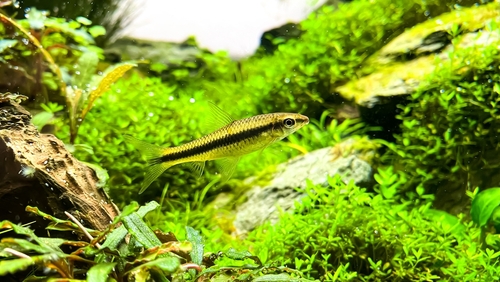
- Scientific Name: Crossocheilus oblongus
- Other Compatible Species: Tetras, Danios, Guppies
- Full Size: 5 to 6 inches
- Care Difficulty: Easy
- Origin: Southeast Asia, mainly Malaysia and Thailand
If you want to have the cleanest tank around, then combining Plecos with Siamese Algae Eaters is definitely the way to go. They live up to their name, and they also have a striking appearance with strong black stripes running all the way down their long bodies.
Pros:
- Clean the tank, interesting behavior, and can be kept singly or in pairs/groups
Cons:
- Prefer the bottom of the tank and can disturb shy species
10. Corydoras Catfish

- Scientific Name: Corydoras paleatus
- Other Compatible Species: Tetras, Rasboras, Swordtails
- Full Size: 2 to 4 inches
- Care Difficulty: Easy
- Origin: South America
You won’t find many lists of friendly tank mates that don’t include the Corydoras Catfish, as it’s one of the friendliest and least aggressive aquarium species you can get your hands on. They also have a very sweet appearance and very similar needs to your Plecos, since they’re also a type of catfish.
Pros:
- Similar needs and peaceful personalities
Cons:
- Prefer the bottom of the tank, but are active at different times of the day
11. Corydoras Catfish

- Scientific Name: Kryptopterus vitreolus
- Other Compatible Species: Mollies, Swordtails, Kuhli Loaches
- Full Size: 4 to 5 inches
- Care Difficulty: Moderate
- Origin: Thailand and Malaysia
You might assume that catfish all have a similar appearance, but this species is here to prove you wrong. They have remarkable, see-through bodies that make them truly unique and fascinating to look at, and they like to explore higher levels of the tank rather than sticking to the substrate at the bottom.
Pros:
- Incredible appearance and peaceful personalities
Cons:
- Timid and can be vulnerable to any changes in their water parameters
12. Silver Dollars
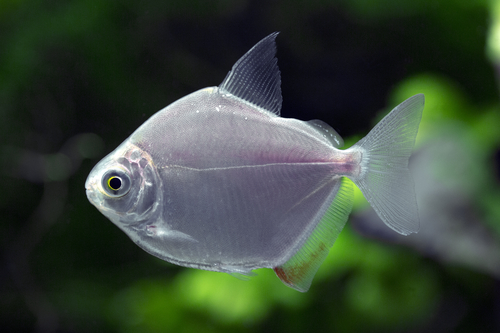
- Scientific Name: Metynnis argenteus
- Other Compatible Species: Kuhli Loaches, Cory Catfish, Small Cichlids
- Full Size: 5 to 6 inches
- Care Difficulty: Intermediate
- Origin: South America
This is a species that you can probably picture just from its name alone. They have flat, round bodies and shiny silver coloring, and they make great tank mates for a Pleco. Silver Dollars are quite skittish and like to swim at the surface, though they do have particular needs and can feel stressed quite easily.
Pros:
- Beautiful and occupy a different part of the tank from your Plecos
Cons:
- Slightly more complex care needs and like to have lots of places to hide
13. Angelfish
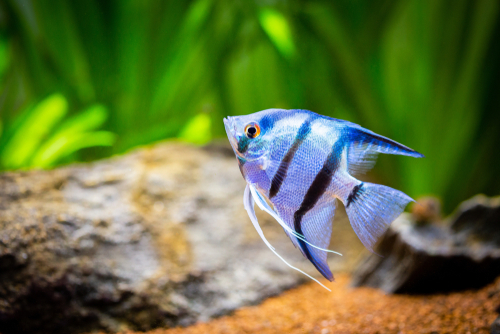
- Scientific Name: Pterophyllum Heckel
- Other Compatible Species: Cory Catfish, Small Tetras, Hatchetfish
- Full Size: 3 to 4 inches
- Care Difficulty: Easy
- Origin: Tropical South America
Plecos are one of the few species that will live in perfect harmony with the much-beloved aquarium icon that is the Angelfish. Their stunning, flowing fins make them vulnerable to any slightly aggressive species and they can fight with timid fish to defend their territory.
Pros:
- Amazing appearance and relatively simple care needs
Cons:
- May bully smaller and more shy species
Summary: 13 Best Pleco Tank Mates
So, what are the best Pleco tank mates? Well, you have a lot of options to choose from but you should be looking for fish that have peaceful personalities, are a similar size or smaller, and are not going to harass your Plecos by occupying their space too often.
Among the top choices out there are aquarium classics like Guppies, Mollies, and Platies, or you could opt for something a little different, like Siamese Algae Eaters or Glass Catfish.
FAQs
How many Plecos can live together?
For most tanks, it is best to keep just one Pleco as they need quite a lot of room, however, a larger tank could house multiple.
Can I mix Plecos?
More than one Pleco species can live comfortably together as long as they have enough space. However, some are shyer than others and can feel anxious around overly active and greedy Plecos (like the Common Pleco), potentially missing out on food.
Do Plecos keep the tank clean?
Plecos will eat algae and some of the debris that falls to the bottom of the tank, so they do help to keep your aquarium clean.

Ian Sterling, founder of Fishlab.com, began his aquarium journey over 30 years ago, driven by a deep fascination for fish and their diverse personalities. His website, Fishlab.com, is dedicated to making fishkeeping accessible and enjoyable, offering beginner-friendly guidance, expert insights, and a community for aquarists to connect and share experiences.


